Introduction
Physiotherapy in Kitchener for Foot Issues
Welcome to Kitchener Physiotherapy & Wellness resource on Claw Toes and Hammer Toes.
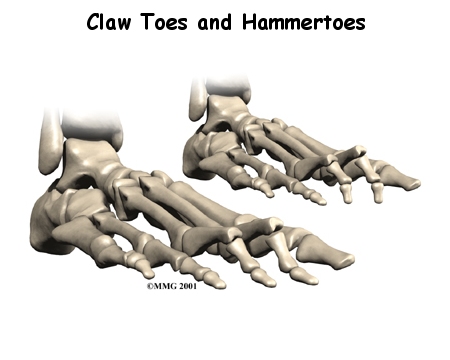 Claw toe and hammer toe conditions are fairly common in cultures that wear shoes. In most cases, these problems can be traced directly to ill-fitting shoes.
Claw toe and hammer toe conditions are fairly common in cultures that wear shoes. In most cases, these problems can be traced directly to ill-fitting shoes.
This guide will help you understand:
- how claw toe and hammer toe conditions develop
- how the conditions cause problems
- what treatment options are available
- what Kitchener Physiotherapy & Wellness approach to rehabilitation is
#testimonialslist|kind:all|display:slider|orderby:type|filter_utags_names:Foot therapy|limit:15|heading:Hear from some of our *Foot Therapy* patients#
Anatomy
What part of the toe is affected?
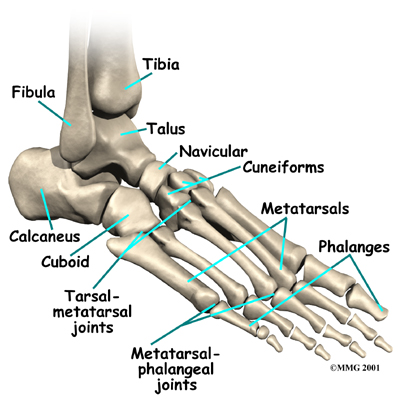 The forefoot and toes are made up of several bones. Each of the four smaller toes starts with a metatarsal bone within the forefoot. Moving down the foot from the metatarsal bone are three smaller bones, called phalanges (the big toe only has two.) The first of these small bones is called the proximal phalanx. Next comes the middle phalanx, and last is the distal phalanx. Proximal means closer, distal means further away.
The forefoot and toes are made up of several bones. Each of the four smaller toes starts with a metatarsal bone within the forefoot. Moving down the foot from the metatarsal bone are three smaller bones, called phalanges (the big toe only has two.) The first of these small bones is called the proximal phalanx. Next comes the middle phalanx, and last is the distal phalanx. Proximal means closer, distal means further away.
The toe bones connect to form the toe joints. The metatarsophalangeal joint (or MTP joint) is the first joint that connects the toe to the foot. The ball of the foot is formed by the MTP joints. The second joint is the proximal interphalangeal joint (or PIP joint), and the last is the distal interphalangeal joint (or DIP joint). A joint capsule made of ligaments and connective tissue holds the bones together and surrounds each joint. Two tendons run along the bottom of each toe that allow us to curl our toes, and one tendon runs along the top that raises the toe.
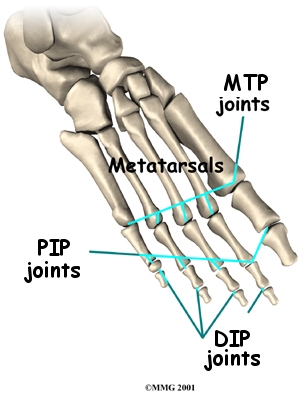
In a hammer toe deformity, the first joint (MTP) is cocked upward, and the middle joint (PIP) is bent downward. A claw toe deformity has a cocked up MTP joint, and both the middle joint (PIP) and the small joint at the end of the toe (the DIP) are curled downward like a claw.
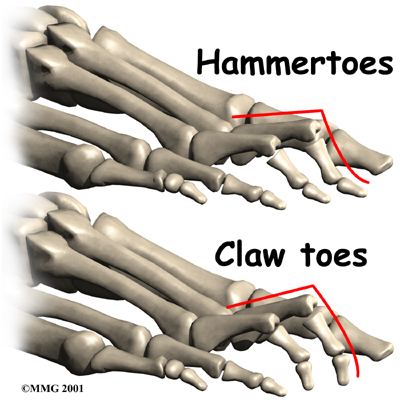
Related Document: Kitchener Physiotherapy & Wellness Guide to Foot Anatomy
Causes
Why do I have this problem?
Both of these problems are often, but not exclusively, the result of wearing a shoe that is too short. In many people, the second toe is actually longer than the big toe, and if shoes are sized to fit the big toe, the second and maybe even the third toe will have to bend to fit into the shoe. Shoes that are pointed make matters even worse. If you combine pointed shoes with high heels then the foot is constantly being pushed downhill into a wall with the toes squished like an accordion.
A hammer toe in the second toe is also common in people who have a bunion in the big toe. The big toe angles too far toward the middle of the foot, and the second toe can end up with a hammer toe deformity.
Claw toes are common in people with high arches. Claw toes can come from a muscle imbalance in which the deeper (intrinsic) toe muscles are weaker than the surface (extrinsic) muscles of the toes. This type of muscle imbalance can also occur from more serious nerve problems.
Symptoms
What does the condition feel like?
Eventually, toes that are squished day after day become fixed in that position and will not straighten out. When this occurs, pressure builds in three places:
- at the end of the toe
- over the PIP joint
- under the MTP joint
Painful calluses can develop as a result of pressure from the shoe.
Diagnosis
How do health care professionals identify the condition?
Diagnosis of these two conditions is usually obvious from the physical exam. In some cases, it is important to check to make sure no other nerve problems are to blame for the condition, particularly when claw toes are present. Other special tests may be required.
Treatment
What can be done for the problem?
Treatment for hammer or claw toes at Kitchener Physiotherapy & Wellness can be quite helpful if the deformity of the foot is not too advanced and the tissues of the foot remain flexible.
Your physiotherapist will examine your foot and determine how flexible your toes are, and how far advanced your toe deformity is. Regardless of how far advanced the deformity is or how rigid your toes are, your therapist will advise you on proper footwear. You should wear shoes that are the proper size for you (long enough to allow the longer toes to have room), have wide toe boxes, and that have soft insoles in order to avoid pressure on the toes. You may also need to look for shoes that have more depth in the toe box such that the top of your shoe does not press into the top of your toe. For women it is advisable to avoid wearing high heels as much as possible as this adds to the pressure on the toes. Wearing proper shoes is the single most important action required to avoid the advancement of hammer or claw toes while they are still flexible.
In some cases pressure points or calluses will have developed over the tops of the toes where they have been pushing against the ill-fitting shoe. In these cases your therapist can advise you on how to use pads to protect the callused areas. Your therapist can also discuss trimming the calluses to relieve some of the pressure on them.
If your toes are still flexible and can be straightened out from their claw or hammer toe position then your therapist may mobilize your toe joints to provide a stretch to the tightened tissues and to encourage the joints to move through their normal motions. Your therapist will also show you how to mobilize your own toes, and will prescribe some toe, foot, and calf stretches to encourage your toes to return back into their normal position.
Strengthening exercises will also be prescribed. The goal with strengthening exercises is to improve the muscle balance between the deep (intrinsic) toe muscles and the surface (extrinsic) muscles of the toe. An imbalance of these muscles occurs when the claw or hammer deformity has been present for a period of time. Strengthening exercises might be as simple as pulling a towel on the floor with your toes, pushing your toes into the floor to correct their position, or trying to actively lift your toes up into straighter alignment. In addition, maintaining the proper alignment of your arch will also affect the position of your toes, so exercises to strengthen your arches will also be prescribed. If your arch is significantly high or dropped your therapist may recommend that you trial orthotics to support the arch and correct the biomechanics of the foot.
Your physiotherapist may also try taping or strapping your affected toes to encourage the toes to return to a normal position. Commercially made straps are also available for hammer and claw toes. Your therapist can advise you regarding whether a brace or tape (or both) may be useful in your individual case. All rehabilitation treatment and exercises are designed to encourage your toes to return to their normal position and to avoid ongoing stress on the foot, which adversely affects the position of your toes. Abnormal alignment or biomechanics anywhere in the lower limb can lead to poor use of the foot and add pressure onto an already painful toe therefore your therapist will assess your overall lower limb alignment and biomechanics. We may prescribe strengthening or stretching exercises for areas that to you might seem unrelated to your foot, such as your hip, knee or core area. These areas, however, are particularly important in maintaining the alignment and biomechanics through your leg and into your foot and toes.
In some cases your physiotherapist may use modalities such as ultrasound, electrical current, ice or heat to assist with any pain that you are feeling as a result of your toe condition. Unfortunately, the relief provided by these modalities will only be temporary if the toe deformity itself is not corrected, therefore the main goal of therapy will be to encourage a return to normal position of the affected toe or toes.
If your toe condition is more advanced and the toes will not completely straighten out on their own, a contracture may exist. A contracture occurs when tissue tightens around a joint and keeps it from moving through its normal range of motion. Surgical treatment is generally required in these cases.
Kitchener Physiotherapy & Wellness provides services for physiotherapy in Kitchener.
Surgery
If all else fails, surgery may be suggested to correct the alignment of the toe. The main type of procedure performed for these conditions is referred to as an arthroplasty. Arthroplasty is the reconstruction or replacement of a joint. Tendon transfers may also be used to restore alignment and function of the joint.
One of the most common procedures to correct the hammer and claw toe deformity is an arthroplasty of the PIP joint. In this procedure an incision is made over the joint. Once the surgeon can see the joint, the end of the proximal phalanx is removed to shorten the toe and relax the contracture around the joint. The toe is then either held with metal pins or sutures in the straight position until it heals.
As the joint heals, scar tissue forms, connecting the two bones together and replacing the area where the joint once was. Surgeons refer to this as a false joint (or pseudo joint) because the scar tissue allows a bit of motion to occur between the two bones while keeping them from rubbing together and causing pain.
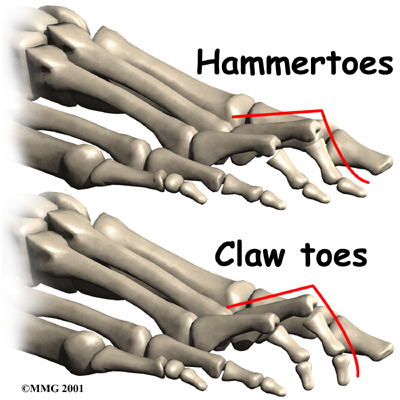
If clawing is a problem, then the MTP joint may also have to be released to relieve the contracture of this joint and allow the proximal phalanx to come into the correct position. This procedure is performed by making an incision on the top of the toe over the MTP joint. The surgeon then releases the tight ligaments and tendons until the toe easily moves back into the proper alignment. The toe may be held in the proper alignment with a metal pin until the soft tissues heal. The pin may remain in place for three or four weeks.
After Surgery
Patients are usually fitted with a post-op shoe. This shoe has a stiff, wooden sole that protects the toes by keeping the foot from bending. Any pins inserted are usually removed after the bone begins to mend (usually two to four weeks post surgically).
You will probably wear a bandage or dressing for about a week following the procedure. The stitches are generally removed in 10 to 14 days, however, if your surgeon chose to use sutures that dissolve, you won't need to have the stitches taken out.
Post-Surgical Rehabilitation
What should I expect for rehabilitation after surgery?
You should begin physiotherapy at Kitchener Physiotherapy & Wellness as soon as your surgeon allows it. Often it is advised to begin therapy as soon as the stitches are removed.
If you are still using crutches at the time of your first appointment at Kitchener Physiotherapy & Wellness your physiotherapist will ensure that you are using your crutches well on both level ground as well as on stairs. The length of time that you will require crutches will be different for each patient but it is advisable to use your crutches or even one crutch or a stick/cane until you can walk virtually without any limp at all. Limping can lead to a host of other pains in your knee, hip or back therefore it is wise to continue to use a walking aid until your physiotherapist advises you that you are walking well enough to go without.
The specific physiotherapy treatment you receive at Kitchener Physiotherapy & Wellness will depend on exactly what surgical intervention has been done with your toe. If you have ongoing pain from the surgical procedure, your therapist may use modalities such as electrical current, ultrasound, ice or moist heat to reduce the pain. They may also use gentle massage on your foot and calf as well as light mobilizations or traction to the joints of the toe and foot to assist with pain and any ongoing swelling in addition to improving mobility of the foot.
Both the range of motion and strength in your foot, and likely your entire low limb will be decreased due to the surgical procedure, your altered gait pattern from pre-surgical pain, as well as from using crutches and a special shoe. Your physiotherapist will prescribe some stretching exercises for your toe, foot and calf, as well as some strengthening exercises for the same areas. The goal of the stretches will be to return your toe and foot to normal position (or as close to it as possible), and to stretch out any muscles that may be adversely pulling on the foot and toe, causing unnecessary strain. Strengthening exercises for the foot are aimed at improving any muscle imbalances that exist in the small muscles of the foot as well as strengthening the arch of the foot to maintain proper foot alignment. These exercises may be as simple as scrunching a towel with your toes, pressing your toes flat into the floor, or may include the use of exercise bands to add resistance. Since the alignment of the foot is maintained by not only the muscles of the foot, but also those of the hip, knee, and core area, your therapist will also assess your overall lower limb alignment and prescribe strengthening exercises for any areas that require it. Maintaining proper alignment is particularly important to avoid future problems with the foot and surgical toe.
As you get stronger your physiotherapist will prescribe more difficult exercises to improve your muscle endurance such as standing on your foot on an uneven surface, repetitively raising up onto your toes, and maintaining the position where you are up onto your toes for an extended period. These exercises will also improve your foot’s proprioception, which is the ability to know where you foot is without looking at it.
The final part of our treatment at Kitchener Physiotherapy & Wellness will be to ensure that you are walking with a proper gait. Being that each person take thousands of steps per day, if you are walking inefficiently or with poor alignment, it can quickly and easily lead to further pain and problems in your foot or up into your ankle, knee, or hip. A period on crutches or in a special shoe in itself often leads to a poor walking pattern that carries on once you are off the crutches or out of the shoe. Your physiotherapist will address any abnormal walking pattern and teach you how to correct it. The strengthening exercises that we prescribe (discussed above) will be important to gain enough strength and control to walk normally after your surgery.
Once your foot is mobile and strong enough, we will encourage you to partake in longer periods of walking to build up further endurance. We will also ask you to incorporate periods of uphill walking which helps to both improve the range of motion in your toes and also increase the strength of the foot. Any pain during activity, particularly during endurance type activities should be heeded, as it is a sign of doing too much.
In addition to ensuring you are walking well, your therapist will discuss footwear with you. As mentioned above, you will wear a special shoe for 2-4 weeks post-surgically, which protects the toe and restricts the bending of it. After this you will gradually be able to return to normal footwear. Your therapist will thoroughly discuss which shoes are best for you to wear to avoid foot pain in the future. As mentioned above, improper footwear is one of the biggest causes leading to hammer and claw toes therefore advice around footwear should be heeded. Shoes with soft soles, as well as wide and deep toe boxes will be recommended. For women, the use of high heels should be limited.
At Kitchener Physiotherapy & Wellness we believe that it is important for you to maintain your cardiovascular fitness while you are recovering from the surgery for your toe. Although extended endurance walking or jogging will not be recommended until you are well into your recovery, in the early stages you can still use a stationary cycle, a rowing machine, or can get in the pool once the scar is healed to partake in water running or aerobics. Your therapist can advise you on an appropriate cardiovascular program for your needs.
Generally recovery from surgery for a hammer or claw toe goes extremely well. If however, you are not improving as your physiotherapist at Kitchener Physiotherapy & Wellness would expect, we will ask you to follow up with your surgeon to confirm that there are no complications from the surgery or problems in your foot that are impeding your recovery.
Portions of this document copyright MMG, LLC
Kitchener Physiotherapy & Wellness provides services for physiotherapy in Kitchener.
 Claw toe and hammer toe conditions are fairly common in cultures that wear shoes. In most cases, these problems can be traced directly to ill-fitting shoes.
Claw toe and hammer toe conditions are fairly common in cultures that wear shoes. In most cases, these problems can be traced directly to ill-fitting shoes.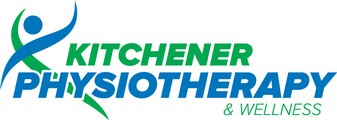









 The forefoot and toes are made up of several bones. Each of the four smaller toes starts with a metatarsal bone within the forefoot. Moving down the foot from the metatarsal bone are three smaller bones, called phalanges (the big toe only has two.) The first of these small bones is called the proximal phalanx. Next comes the middle phalanx, and last is the distal phalanx. Proximal means closer, distal means further away.
The forefoot and toes are made up of several bones. Each of the four smaller toes starts with a metatarsal bone within the forefoot. Moving down the foot from the metatarsal bone are three smaller bones, called phalanges (the big toe only has two.) The first of these small bones is called the proximal phalanx. Next comes the middle phalanx, and last is the distal phalanx. Proximal means closer, distal means further away. 


